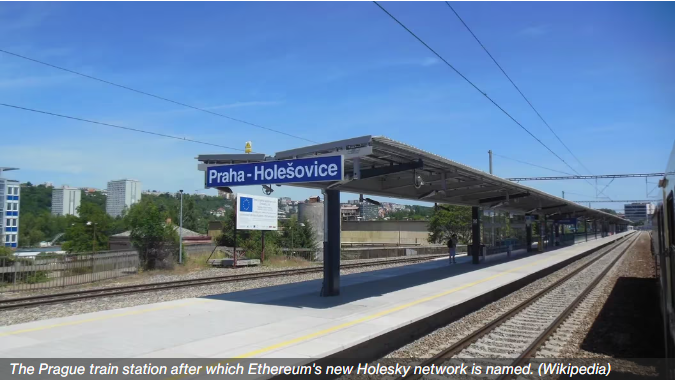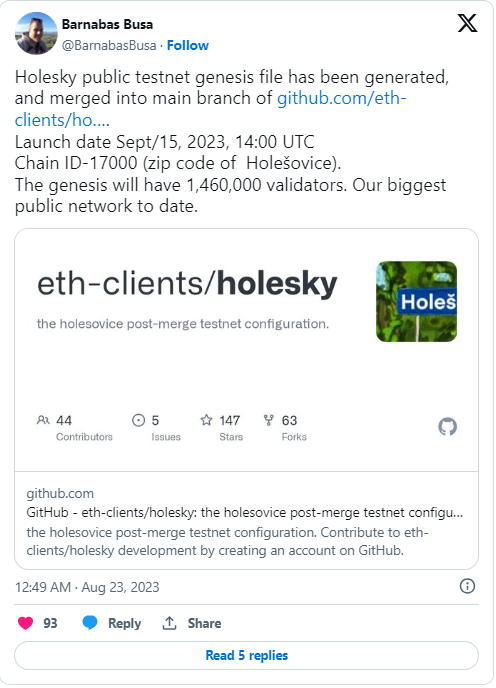Understanding Holesky in One Article: The First Proof-of-Stake Consensus Testnet After Ethereum Merge
Source: U.today
Compiled by: Jordan, PANews
This week, the Ethereum testnet Goerli announced its retirement, with the new generation testnet Holesky taking over its mission. Undoubtedly, this is a significant milestone in the development of Ethereum. So, what exactly prompted Ethereum to decide to retire Goerli in 2023, and what makes the highly anticipated "successor" Holesky testnet special?
Replacing Goerli: Ethereum's New Testnet Holesky Officially Launched
September 15, 2023, marks the one-year anniversary of Ethereum's mainnet merge, and Ethereum chose this day to take the Goerli testnet offline, migrating all developers to the latest test network—Holesky. This test network is also Ethereum's first proof-of-stake (PoS) testnet, with key information as follows:
The Ethereum test network Holesky (also known as Holešky, Holeše ovice) was originally scheduled to launch on September 15, 2023 (Note from PANews: It actually failed to launch due to network configuration errors and will restart in 1-2 weeks).
Holesky officially replaces Goerli, becoming a testnet that supports Ethereum staking, infrastructure, and protocol development.
For stress testing dApps, experimenting with smart contracts, and other EVM-related programs, developers can refer to the Sepolia testnet.
Holesky is the first Ethereum testnet based on proof-of-stake consensus.
Holesky will effectively address the scalability issues of the Goerli testnet, including the shortage of goETH testnet tokens and the low number of validators.
Holesky has 1.46 million validators, nearly double that of the Ethereum mainnet.
The Holesky testnet will be in use until 2028.
The launch of Holesky provides Ethereum developers with a brand new "sandbox" testing environment where testers can validate various functions of Ethereum chain protocols, products, and services.
Basic Knowledge: The Importance of Ethereum Testnets
In the cryptocurrency field, a testnet is an experimental distributed network that can simulate various transaction processes occurring on a cryptocurrency network without actual value transfer. Like the mainnet, accounts can send tokens to each other, while validators confirm tokens by adding new blocks to the chain.
Ethereum testnet users can obtain participation tokens from a "faucet," which is a free testnet usage mechanism. Users can receive distributed free test ETH by completing certain tasks (such as sharing social media accounts, connecting to Discord, etc.).
For dApps, stress testing is essential, and testnets allow project teams to avoid the "money loss" risk. Therefore, whether for DeFi protocols or crypto wallets, testing is conducted on the testnet before deployment on the mainnet.
Ropsten, Rinkeby, Goerli, Sepolia: Crucial Ethereum Testnets
As the second-largest cryptocurrency by market capitalization and the first programmable blockchain with smart contracts, Ethereum has utilized multiple testnets over its 8-year history—
In 2016, Ethereum launched the Ropsten testnet, replacing Morden. Ropsten is the first proof-of-work (PoW) Ethereum testnet, and most dApps currently used on the Ethereum mainnet were tested on the Ropsten platform. It was also the first testnet to "merge" during Ethereum's transition from PoW to PoS.
In 2017, Ethereans launched Rinkeby, a testnet based on the Clique proof-of-authority (PoA) consensus mechanism. It is a modified version of the Ethereum proof-of-stake (PoS) testnet, but this testnet can only interact with the Go Ethereum (Geth) version of client software.
In 2018, at the ETH Berlin conference, Ethereum developers introduced Goerli as a multi-client testnet, meaning Goerli can transact with Ethereum software versions written in different programming languages.
In 2021, the Ethereum Sepolia testnet was launched, with an unlimited number of tokens.
Holesky: A "Very Special" Ethereum Testnet
Frankly speaking, the Ethereum Holesky testnet should be considered an attempt by core developers to address all the issues faced by previous testnets and their teams. Holesky is the first testnet launched after the "Ethereum merge," meaning Holesky has no proof-of-work (PoW) version. Notably, the name "Holesky" is said to be derived from the Nádraží Holešovice subway station in Prague, the capital of the Czech Republic.

The launch of Holesky inevitably raises the question: What problems did the Goerli testnet face? In fact, the Goerli testnet, launched in 2018, did have some drawbacks, such as users frequently facing shortages of GoETH test tokens, forcing them to purchase tokens themselves, and even leading to speculation on testnet tokens. This situation clearly contradicts the original intention of a testnet, and such issues should be effectively resolved with the launch of Holesky. According to the creators of the Holesky testnet, they allocated over 2 billion HoleskyETH at launch, a quantity sufficient to meet all developers' needs.

Additionally, the Holesky testnet will have an unprecedented number of validators: 1.46 million validating entities will protect the network's integrity, a number greater than the combined total of the Ethereum mainnet (over 800,000 validators) and the Goerli testnet (approximately 512,000 validators). Conversely, this will enable developers to more accurately simulate "real-world" Ethereum (ETH) operations.
On the other hand, Holesky will also collaborate with the Sepolia testnet. Like previous Ethereum testnets, Holesky has its own set of validators, block explorers, and faucet ecosystems. Sepolia serves as a platform for testing smart contracts, decentralized applications, and all EVM functionalities. The collaboration between the two will promote Holesky as a technical platform capable of conducting staking design, Ethereum universal infrastructure, and protocol-level development thought experiments.
Moreover, like other EVM ecosystem blockchains, Holesky has a set of network specifications. Users connecting to this testnet need to pay attention to some key parameters, as follows:
|-----------------------|-------------------------------| | Name | Holesky | | Flag | --holesky | | Network ID | 17000 | | Chain ID | 17000 | | Block explorer | https://holesky.beaconcha.in/ | | Launch epoch | 1694786400 |
It is reported that the Holesky testnet will continue to operate until around 2028, with an expected operational period until December 2028. Developers can immediately claim some HoleskyETH test tokens and start using the Holesky testnet. If you also want to experience it, feel free to give it a try.









